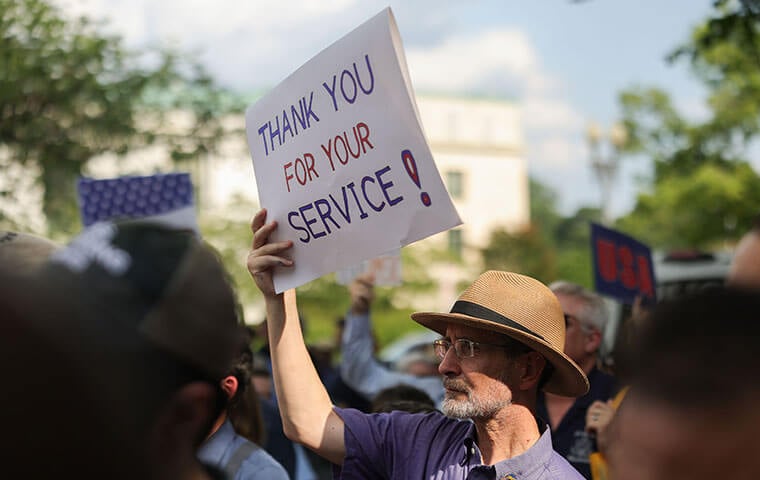 Rally outside of the Department of State headquarters in Washington, D.C. on July 11, 2025 in support of employees who were laid off by the agency. Roughly 1,300 State Department staff were laid off on Friday as part of a reorganization plan at the agency which aligns with President Donald Trump's agenda to downsize the federal government. Image: Bryan Dozier/NurPhoto/Shutterstock
By: FEDweek Staff
Rally outside of the Department of State headquarters in Washington, D.C. on July 11, 2025 in support of employees who were laid off by the agency. Roughly 1,300 State Department staff were laid off on Friday as part of a reorganization plan at the agency which aligns with President Donald Trump's agenda to downsize the federal government. Image: Bryan Dozier/NurPhoto/Shutterstock
By: FEDweek StaffFollowing the U.S. Supreme Court’s action to clear the way for RIFs and agency reorganizations government-wide, an uneasy wait has been hanging over the federal workforce.
The first move following that decision was the State Department’s announcement of a reorganization and cut of more than 1,300 jobs. RIF notices were sent late last week, triggering a 120-day notice for Foreign Service employees and a 60-day notice for others.
The Education Department may be next in line; the Supreme Court on Monday in a 6-3 decision lifted an injunction against the planned cut of some 1,400 employees there, more than a third of its workforce. The department had sent RIF notices in March, only to be blocked by a lower court order; exact timing of restarting the process there is uncertain.
Many more are expected. The high court’s lifting of a nationwide injunction against RIFs and reorganizations involved a case in which the Trump administration said that some 40 RIFs across 17 agencies were at issue. Separately, OPM said it expected “tens of thousands” of jobs to be eliminated in those cutbacks.
However, the Supreme Court decision did not end the involvement of the federal courts. The ruling stressed that the dispute before the high court was over the executive order and guidance telling agencies to plan to undertake wide-scale RIFs and reorganizations, and not over “the plans themselves. Those plans are not before this Court.”
That returned the case to a judge of the U.S. District Court for the Northern District of California, who already has ordered the government to provide those plans for her review—raising the prospect of injunctions blocking RIFs and reorganizations agency-by-agency, setting off another round of appeals.
The suit against the Education Department layoffs—arguing that they would leave it unable to carry out missions Congress has assigned to it—remains pending in the lower courts and more moves by individual agencies to start RIFs almost certainly will be met by challenges on similar grounds. In one such case making that argument regarding HHS, an injunction remains in effect against laying off some of the 10,000 employees who received RIF notices in April, although others have been separated. A separate pending suit asserts that HHS made “glaring errors” in selecting which employees would be separated
Some agencies reportedly are reviewing their plans—mostly crafted three or four months ago, before the injunction that the Supreme Court recently lifted—in anticipation of such suits.
Individual employees also could bring appeals before the MSPB claiming violations of RIF procedures. That agency experienced a surge of appeals earlier this year following the large-scale layoffs of probationary employees, even though they have fewer grounds for appeals than tenured employees.
MSPB hearing officers are continuing to handle cases even though the governing board lacks a quorum to consider appeals of those decisions. In some cases, employees could appeal decisions against them directly into federal court.
Another complicating factor in the wait for clarity is that since the plans were first written, the number of employees who would be facing layoffs likely has changed; acceptance of offers of deferred resignation, early retirement and buyout incentives has created vacancies that are not being filled due to the general hiring freeze.
The VA for example has said that in light of attrition that already has occurred and that is projected, it does not expect to have to conduct what would have been a major layoff; the attrition alone is to cut its workforce by about 29,000 jobs, or 6 percent. OPM has said that government-wide, hundreds of thousands of employees are due to separate, the large majority by October, through deferred resignation alone.
A related issue involves legal challenges to President Trump’s executive order to revoke union representation and repudiate existing contracts involving the majority of federal employees, citing security reasons. Many contracts include commitments by agencies to take certain steps to reduce the impact on employees of any job reductions; if those contracts remain in effect, they provide unions with another legal route to challenge cutbacks.
In one challenge to that order, the NTEU union has asked a federal judge for summary judgment that the order exceeded a President’s discretion to exclude employees from union representation. The union separately is challenging an appeals court’s action to lift an injunction the judge earlier had issued against the order.
In a separate challenge by the AFGE union, another federal appeals court has temporarily lifted an injunction issued by a trial judge, pending fuller arguments in that case in a matter of days.
Senate Eyes Vote to Pay Federal Employees Working Unpaid
Series of Bills Offered to Address Shutdown’s Impact on Employees
Public Starting to Feel Impact of Shutdown, Survey Shows
OPM Details Coverage Changes, Plan Dropouts for FEHB/PSHB in 2026
Does My FEHB/PSHB Plan Stack Up? Here’s How to Tell
2025 TSP Rollercoaster and the G Fund Merry-go-Round
See also,
TSP Takes Step toward Upcoming In-Plan Roth Conversions
5 Steps to Protect Your Federal Job During the Shutdown
Over 30K TSP Accounts Have Crossed the Million Mark in 2025

